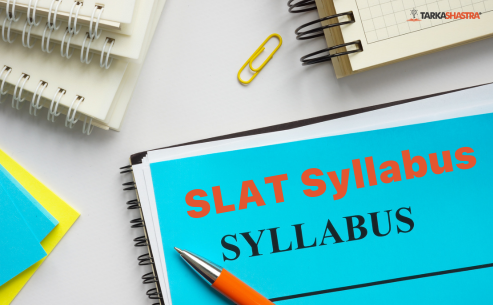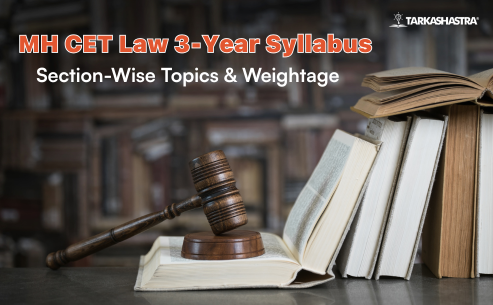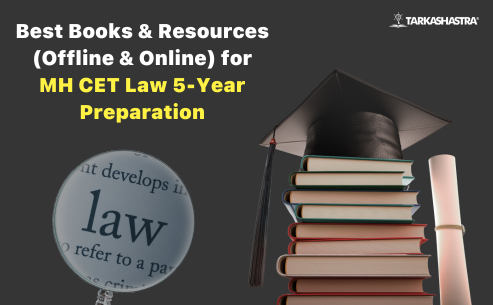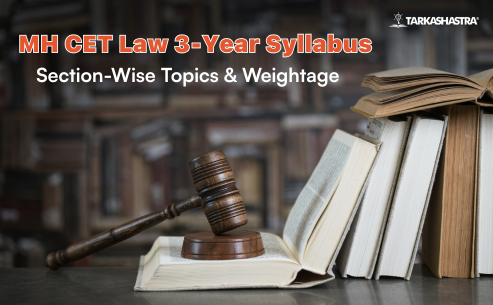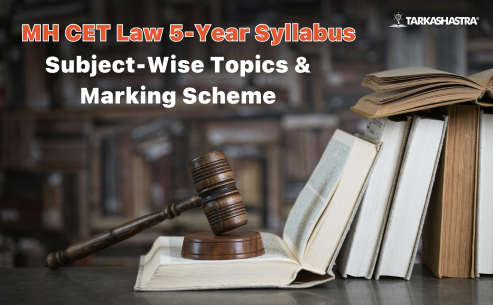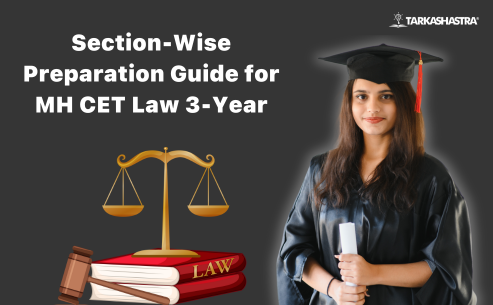The Symbiosis Law Admission Test (SLAT) 2026 is one of India’s most anticipated law entrance exams. It offers admission to the prestigious Symbiosis Law Schools (SLS) in Pune, Noida, Hyderabad, and Nagpur. Every year, thousands of aspirants compete for limited seats in the BA LLB (Hons.) and BBA LLB (Hons.) programs, making SLAT a highly competitive yet student-friendly exam.
For aspirants aiming to crack SLAT 2026, a clear understanding of the syllabus, paper structure, sectional weightage, and recommended resources is essential. Unlike CLAT or AILET, SLAT is designed to test skills like logical reasoning, reading comprehension, and general awareness — rather than deep legal or mathematical knowledge.
A key update for SLAT 2026 is that the Writing Ability Test (WAT) has been officially discontinued, and the Personal Interview (PI), along with the objective test, will now form the entire selection process. This makes it crucial for aspirants to prepare for the 60-mark exam and focus on interview readiness.
This blog’ll provide a comprehensive subject-wise breakdown of the SLAT 2026 syllabus, the test structure with sectional weightage, insights into question difficulty, and a curated list of recommended books and resources.
Here’s a quick snapshot of what the SLAT 2026 exam looks like:
SLAT 2026 – Quick Exam Highlights
| Feature | Details |
| Exam Name | Symbiosis Law Admission Test (SLAT) |
| Conducting Body | Symbiosis International (Deemed University) |
| Courses Offered | BA LLB (Hons.), BBA LLB (Hons.) |
| Participating Institutes | SLS Pune, SLS Noida, SLS Hyderabad, SLS Nagpur |
| Mode of Exam | Computer-Based Test (Online) |
| Language | English |
| Duration | 60 minutes |
| Total Questions | 60 (MCQs) |
| Marking Scheme | +1 for each correct answer, no negative marking |
| Additional Component | Personal Interview (PI) |
| WAT | Discontinued from 2026 |
With this overview in place, let’s move on to the detailed exam structure of SLAT 2026 in the next section.
SLAT 2026 Exam Structure at a Glance
To crack SLAT 2026, aspirants must first understand the exam structure and marking scheme. Unlike law entrance tests focusing heavily on legal theory or mathematics, SLAT maintains a balanced skill-based approach. It evaluates a student’s reasoning ability, legal aptitude, reading comprehension, and awareness of current events, making it accessible to students from all academic streams.
The exam is conducted online (Computer-Based Test) and lasts 60 minutes. Students must attempt 60 multiple-choice questions. Each question carries 1 mark, and no negative marking allows students to attempt all questions confidently.
SLAT 2026 – Exam Pattern Overview
| Component | Details |
| Mode of Exam | Computer-Based Test (Online) |
| Duration | 60 minutes (1 hour) |
| Medium | English |
| Total Questions | 60 (MCQs) |
| Total Marks | 60 |
| Number of Sections | 5 (Logical Reasoning, Legal Reasoning, Analytical Reasoning, Reading Comprehension, General Knowledge) |
| Questions per Section | 12 |
| Marking Scheme | +1 mark for each correct answer |
| Negative Marking | None |
| Additional Component | Personal Interview (PI) – conducted online |
| Writing Ability Test (WAT) | Discontinued in 2026 |
Key Features of SLAT 2026 Exam Structure
- Equal Weightage: All 5 sections are equally important, with 12 questions each.
- No Sectional Time Limit: Students can freely navigate between sections during the exam.
- Balanced Skill Testing:
- Reasoning (Logical + Analytical)
- Language (Reading Comprehension)
- Awareness (General Knowledge)
- Legal Aptitude (Principle-based Legal Reasoning)
- Selection Process: The Final merit list is based on SLAT Score + PI performance.
Pro Tip: Since all sections have equal weightage, students should adopt a balanced preparation strategy instead of focusing only on one area, like Legal Reasoning or GK.
Section-Wise SLAT 2026 Syllabus Breakdown
The SLAT 2026 exam is divided into five equally weighted sections, each carrying 12 questions. Below is the detailed syllabus for each subject area, beginning with Logical Reasoning.
1. Logical Reasoning
Logical Reasoning is one of the highest-scoring sections in SLAT 2026. It evaluates a student’s ability to identify patterns, analyse relationships, and apply structured reasoning to solve problems. The questions are moderate in difficulty and usually puzzle—or argument-based.
Key Topics in Logical Reasoning
- Syllogisms
- Blood Relations
- Coding–Decoding
- Number & Letter Series
- Directions & Ranking
- Analogies
- Statement & Assumption
- Statement & Conclusion
- Cause & Effect
- Premises & Inferences
- Logical Sequences
- Argument–Conclusion
Skills Tested
- Critical thinking and decision-making
- Ability to connect ideas and derive valid conclusions
- Recognising assumptions and hidden premises in arguments
Question Style & Difficulty
- Assumption–conclusion, statement–argument, coding-decoding, and logical sequences
- Difficulty: Moderate
- Requires practice in speed and accuracy
Table: Logical Reasoning – Syllabus Snapshot
| Sub-Topic | Example Question Type | Difficulty Level |
| Syllogisms | “All A are B, Some B are C…” | Moderate |
| Blood Relations | “A is the brother of B, who is C’s father…” | Easy to Moderate |
| Coding–Decoding | “If CAT = 3120, then DOG = ?” | Moderate |
| Cause & Effect | Identifying the cause behind an effect | Moderate |
| Logical Sequences | Completing patterns/series | Moderate |
Preparation Tip: Dedicate at least 15 minutes daily to reasoning puzzles and solve 10–15 questions to build speed. Focus on mock tests and past-year patterns for accuracy.
2. Legal Reasoning
The Legal Reasoning section of SLAT 2026 tests a candidate’s ability to apply legal principles to factual situations, rather than test prior knowledge of law. This makes it equally approachable for students from non-law backgrounds. The focus is on logical application and interpretation.
Key Topics in Legal Reasoning
- Fundamental Legal Principles & Application
- Indian Constitution (Fundamentals, Rights, Duties, Amendments)
- Legal Maxims & Terminology
- Criminal Law (IPC & CrPC Basics)
- Law of Torts (Negligence, Vicarious Liability, Strict Liability)
- Contracts (Offer, Acceptance, Consideration, Breach)
- Intellectual Property Rights (IPR) – Basics
- Important Supreme Court Judgments & Legal Developments
- International Law & Treaties
- Current Legal Awareness (Recent Bills, Acts, Amendments)
- Fact-based legal scenarios (principle + facts application questions)
Skills Tested
- Understanding the rule–fact relationship
- Applying legal principles to real-world examples
- Logical interpretation of case scenarios
Question Style & Difficulty
- Primarily principle-fact based questions (e.g., “If X does this, and according to principle Y, what will be the legal outcome?”).
- No requirement to memorise entire sections of IPC or Constitution.
- Difficulty: Moderate
Table: Legal Reasoning – Syllabus Snapshot
| Sub-Topic | Example Question Type | Difficulty Level |
| Legal Maxims | “What does Res Ipsa Loquitur mean?” | Easy |
| Constitution | “Which article guarantees Right to Equality?” | Moderate |
| Torts | Principle-fact scenarios on negligence/liability | Moderate |
| Contracts | “If A offers B ₹10,000 for a service and B accepts…” | Moderate |
| Current Legal Affairs | Recent amendments, landmark cases | Moderate to High |
Preparation Tip: Practice principle-fact-based questions from previous SLAT/CLAT papers instead of rote learning. Stay updated with recent judgments and constitutional amendments, as current legal awareness often appears in SLAT.
3. Analytical Reasoning
The Analytical Reasoning section in SLAT 2026 checks your ability to analyse patterns, solve data-driven problems, and apply logical thinking to numerical and situational challenges. Unlike heavy quantitative aptitude in other exams, this section focuses more on logic-based numerical reasoning at a basic to moderate level.
Key Topics in Analytical Reasoning
- Number Series & Letter Series
- Data Interpretation (basic tables, graphs, pie charts)
- Profit & Loss (basic level)
- Ratios, Percentages, Averages (conceptual application only)
- Age Problems
- Blood Relations & Directions
- Puzzles & Arrangements
- Venn Diagrams & Sets
- Deductive Reasoning (True/False type logic)
- Odd-One-Out, Classification & Pattern Recognition
Skills Tested
- Quick data analysis & Interpretation
- Logical sequencing & elimination techniques
- Ability to apply arithmetic concepts in reasoning form
Question Style & Difficulty
- Includes blood relations, direction sense, DI sets, series & puzzles.
- Most questions are easy to moderate and designed to be solved quickly within a minute.
Table: Analytical Reasoning – Syllabus Snapshot
| Sub-Topic | Example Question Type | Difficulty Level |
| Series (Numbers/Letters) | “Find the missing term: 2, 6, 12, 20, ?” | Easy |
| Data Interpretation | Table-based calculations | Moderate |
| Ratios & Percentages | “If A:B = 2:3 and total = 50, find A” | Easy |
| Venn Diagrams | Overlap of sets | Easy to Moderate |
| Puzzles & Arrangements | Seating arrangements, direction sense | Moderate |
Preparation Tip: Since each section carries equal weightage, don’t ignore this! Practice short DI sets, puzzles, and quick math-based reasoning daily. Even solving 10–12 questions per day can boost your confidence here.
4. Reading Comprehension (RC)
The Reading Comprehension section of SLAT 2026 evaluates your ability to read, interpret, and analyse written text quickly. This section scores highly if you have good reading speed, vocabulary, and inference skills. Passages are usually short to medium (200–300 words), making them easier to manage under time pressure.
Key Topics in Reading Comprehension
- Short passages with inference-based questions
- Vocabulary in context (synonyms, antonyms, analogies)
- Identifying the main idea and central theme
- Determining the author’s tone and intent
- Fact vs. Opinion questions
- Error spotting, grammar-based comprehension
- Sentence rearrangement & improvement
- Idioms, phrases, and one-word substitutions
Skills Tested
- Speed reading with accuracy
- Drawing inferences from passages
- Strong vocabulary and grammar awareness
- Ability to detect tone, style, and argument structure
Question Style & Difficulty
- 2–3 passages with 3–5 questions each
- Includes vocabulary and inference-based MCQs
- Difficulty: Moderate (time-consuming if not practised)
Table: Reading Comprehension – Syllabus Snapshot
| Sub-Topic | Example Question Type | Difficulty Level |
| Vocabulary in Context | “Find the synonym of pervasive in the passage” | Moderate |
| Central Idea | “What is the main theme of the passage?” | Easy to Moderate |
| Tone Detection | “The author’s tone in this passage is…” | Moderate |
| Fact vs Opinion | Identify statements supported by the text | Moderate |
| Grammar & Usage | Spotting errors, rearranging sentences | Easy to Moderate |
Preparation Tip: Read newspaper editorials (The Hindu, Indian Express) daily for improving comprehension speed and tone recognition. Practice at least 2–3 RC sets per week and note down new vocabulary words.
5. General Knowledge (GK & Current Affairs)
The General Knowledge section in SLAT 2026 carries equal weightage as the other four sections and often acts as a decisive score booster. Since the questions are direct and fact-based, well-prepared candidates can save time and use it in time-consuming sections like RC or puzzles.
Key Topics in GK & Current Affairs
Static GK:
- Indian Polity & Constitution (Fundamental Rights, Amendments)
- History & Geography (important events, movements, places)
- UN & International Bodies
- Important Days & Themes
- Awards & Honours (national & international)
- Sports & Cultural Events
Current Affairs (last 8–10 months):
- National & International News
- Government Policies, Schemes & Bills
- Recent Supreme Court Judgments
- Environmental Agreements & Summits
- Science & Technology Developments
- Economic & Political Affairs
- Eminent Personalities in the News
Skills Tested
- Awareness of national and international current affairs
- Ability to recall static facts quickly
- Staying updated with recent legal, political, and social developments
Question Style & Difficulty
- Direct one-liners, multiple-choice questions
- Coverage of events from the past 6–10 months is critical
- Difficulty: Moderate, if consistently updated; otherwise tricky
Table: General Knowledge – Syllabus Snapshot
| Sub-Topic | Example Question Type | Difficulty Level |
| Static GK | “Who is the Chief Justice of India (2025)?” | Easy |
| Current Affairs | “Which country hosted COP-30 Summit in 2025?” | Moderate |
| Awards | “2025 Booker Prize Winner is…” | Easy |
| Sports & Events | “Which team won the ICC Champions Trophy 2025?” | Moderate |
| Govt. Policies | “Which scheme was launched for women empowerment in 2025?” | Moderate |
Preparation Tip: Read monthly current affairs digests (AffairsCloud, GKToday, Tarkashastra GK Capsules) and revise static GK from Lucent GK & Manorama Yearbook. Spend at least 15–20 minutes daily updating GK to secure this section.
Question Style & Difficulty Level
Understanding the question style and difficulty level is as essential as knowing the syllabus. SLAT 2026 is considered more student-friendly than CLAT or AILET. However, within the short 60 minutes, it still requires speed, logic, and accuracy.
The exam balances reasoning, language, and awareness-based skills, ensuring that students from any academic background can perform well with the proper preparation.
Section-Wise Question Style & Difficulty
| Section | Question Style | Difficulty Level |
| Logical Reasoning | Statement–Assumption, Coding-Decoding, Syllogisms, Logical Sequences, Argument–Conclusion | Moderate |
| Legal Reasoning | Principle–Fact Based, Application of Legal Principles, Case Scenarios | Moderate |
| Analytical Reasoning | Blood Relations, Series, Data Interpretation, Direction Sense, Puzzles | Easy to Moderate |
| Reading Comprehension | Short to medium passages with questions on inference, tone, central idea, vocabulary | Moderate |
| General Knowledge | Static GK (Polity, History, Geography), Current Affairs (last 6–10 months), Awards, Government Policies | Moderate (if updated) |
Key Observations
- Balanced Paper: Each section carries equal weightage (12 marks), so no area can be ignored.
- Principle–Fact Orientation: Legal Reasoning does not require prior legal knowledge—only logical application.
- Passage Lengths: Reading Comprehension passages are short, usually 200–300 words, with 3–5 questions each.
- GK Advantage: Well-prepared GK helps save time for tougher sections.
- No Negative Marking: Encourages attempting all questions, but accuracy remains critical to maximise score.
Pro Tips for SLAT 2026 Aspirants
- Practice mock tests in a timed environment (60 Qs in 60 mins).
- Improve reading speed & comprehension for RC and GK sections.
- For reasoning, avoid random guessing and focus on logical elimination techniques.
- Keep current affairs updated till Dec 2025, as questions are based on the latest 8–10 months.
What’s NOT Included in SLAT 2026
While knowing the syllabus is essential, it’s equally crucial to understand what’s not part of SLAT 2026. Many aspirants waste time preparing irrelevant topics like advanced mathematics or lengthy legal theories, which are not tested.
Here’s a clear list to help you focus only on what matters:
Components Excluded from SLAT 2026
| Not Included | Explanation |
| Quantitative Aptitude / Maths (Dedicated Section) | Unlike CLAT, SLAT has no standalone Mathematics section. Only basic numerical reasoning appears under Analytical Reasoning. |
| Sectional Time Limits | No individual timing for each section – you can freely switch between them. |
| Negative Marking | No penalty for wrong answers. This means you can safely attempt all 60 questions. |
| Writing Ability Test (WAT) | Removed from 2026 onwards. Earlier essay-writing is no longer part of the selection. |
| Offline Mode | The exam is strictly Computer-Based (CBT); no pen-paper option available. |
| Assertion–Reason MCQs | Complex formats like assertion-reason questions (common in AILET) are not included. |
Common Mistakes to Avoid
- Don’t study advanced Math chapters like Algebra, Time-Speed-Distance, or Profit & Loss in detail.
- Don’t spend excessive time memorising legal theory—focus on principle–fact applications instead.
- Don’t prepare for essay-writing; the WAT is discontinued.
- Don’t assume Legal Reasoning will have long RC-style passages—it usually has short caselets.
Smart Prep Tip: Keep your prep focused on only five tested areas. Cutting out irrelevant topics saves hours and allows you to concentrate on mock tests, reasoning practice, and GK updates.
Recommended Books & Resources for SLAT 2026
The choice of study material can make or break your SLAT 2026 preparation. Instead of relying on scattered resources, it is best to follow structured, exam-focused content curated by experts who understand the SLAT exam pattern thoroughly.
At Tarkashastra, our specially designed e-Books and Hard Copy Books are crafted to cover every section of the exam—Logical Reasoning, Legal Reasoning, Analytical Reasoning, Reading Comprehension, and General Knowledge.
Why Tarkashastra Books?
- Exam-Specific Content: Every chapter is tailored to match SLAT’s unique style of questions.
- Concept + Practice: Each topic is explained in simple language, followed by ample practice exercises.
- Mock Tests & Sectional Drills: Our books feature sectional tests and full-length mocks, designed by our mentors to accurately reflect the difficulty of actual exams.
- GK Capsules: Monthly updates and compiled current affairs digests help students stay on track with the latest developments.
- PI Readiness Material: Alongside objective test prep, we provide structured resources for Personal Interview preparation.
Section-Wise Recommended Books
| Section | Tarkashastra Resources | Why It Helps |
| Logical Reasoning | Tarkashastra Logical Reasoning e-Book + Practice Sets | Covers puzzles, arrangements, syllogisms, and argument-based questions with detailed solutions |
| Legal Reasoning | Tarkashastra Legal Reasoning Book | Focus on principle–fact-based questions, recent judgments, and constitutional updates |
| Analytical Reasoning | Tarkashastra Analytical Reasoning Workbook | Includes series, DI sets, ratios, percentages, and puzzle-based practice |
| Reading Comprehension & English | Tarkashastra RC & Language Skills e-Book | Improves vocabulary, grammar, tone detection, and inference skills |
| General Knowledge (Static + Current Affairs) | Tarkashastra GK Capsules & Annual GK Compendium | Covers static GK topics + monthly current affairs for last 8–10 months |
Additional Resources
- Tarkashastra Mocks: 15–20 full-length online mocks with AI-driven analysis.
- Daily Quizzes: Quick drills on reasoning, RC, and GK for consistent practice.
- Mentor Notes: Tips and shortcuts from IIM/NLU mentors to boost exam efficiency.
Expert Tip: Avoid juggling multiple publishers’ books. Stick to Tarkashastra’s curated material, revise it thoroughly, and combine it with mock tests for the best results.
Preparation Tips & Strategy for SLAT 2026
SLAT 2026 may appear less intimidating than CLAT or AILET, but its balanced weightage across five sections makes consistent preparation essential. Since each section carries 12 marks, neglecting even one can reduce your chances of making the cut. The key lies in accuracy, speed, and intelligent time management.
1. Section-Wise Preparation Strategy
| Section | Strategy |
| Logical Reasoning | Practice syllogisms, puzzles, and argument-based questions daily. Focus on eliminating wrong choices logically. |
| Legal Reasoning | Practice principle–fact based questions instead of memorizing theory. Stay updated with recent legal judgments & amendments. |
| Analytical Reasoning | Work on series, DI sets, ratios, and puzzles. Time yourself while solving to improve speed. |
| Reading Comprehension | Read editorials from The Hindu/Indian Express daily. Practice RC sets for tone detection, inference, and vocabulary. |
| General Knowledge | Revise static GK weekly and follow daily current affairs (last 8–10 months). Use monthly digests for quick revision. |
2. Time Management Strategy
Since there’s no sectional time limit, you can allocate time flexibly. Ideally:
| Section | Suggested Time |
| Logical Reasoning | ~14 minutes |
| Legal Reasoning | ~14 minutes |
| Analytical Reasoning | ~14 minutes |
| Reading Comprehension | ~13 minutes |
| General Knowledge | ~5 minutes |
Start with your strongest section to build confidence, then move to the tougher ones.
3. Mock Tests & Practice
- Attempt 15–20 full-length mock tests before exam day.
- Analyse mistakes after each mock to identify weak areas.
- Practice sectional tests with a timer to simulate real exam pressure.
- Focus on speed in Logical/Analytical and accuracy in GK/RC.
4. Personal Interview (PI) Preparation
With WAT discontinued, the PI carries significant weight in the final selection. Start early:
- Stay updated with current affairs, law-related news, and constitutional developments.
- Prepare answers for common PI questions: “Why Law?”, “Why Symbiosis?”, “Recent legal case you followed?”.
- Practice mock interviews with mentors or peers to build confidence.
5. Daily Routine for 3 Months Before Exam
- 2 hours – Reasoning practice (Logical + Analytical).
- 1 hour – Reading Comprehension & Vocabulary.
- 1 hour – GK & Current Affairs revision.
- 1 mock test every alternate day in the last month.
Expert Tip: SLAT rewards consistency, not cramming. Even 3–4 hours of focused daily prep for 3–4 months can ensure a high score.
Conclusion
The SLAT 2026 syllabus and exam structure are designed to test your overall aptitude for law, not rote memorisation or advanced mathematics. With five equally weighted sections, no negative marking, and just 60 minutes to answer 60 questions, the exam rewards clarity, speed, and innovative preparation strategies.
Key takeaways for aspirants:
- Focus on the five tested areas: Logical Reasoning, Legal Reasoning, Analytical Reasoning, Reading Comprehension, and General Knowledge.
- Don’t waste time on irrelevant topics like advanced mathematics or essay writing — they’re not part of SLAT 2026.
- Stick to trusted resources and recommended books, revise them multiple times, and practice 15+ mocks before exam day.
- Prepare equally well for the Personal Interview (PI) since it carries significant weight in final admissions.
At Tarkashastra, we specialise in helping students crack exams like SLAT with personalised mentorship, curated GK capsules, mock interview training, and expert guidance. Our structured approach ensures you’re not just exam-ready but admission-ready for Symbiosis Law Schools.
Start early. Stay consistent. And remember: in SLAT, it’s not about doing more — it’s about doing the right things smartly.
Frequently Asked Questions (FAQs) on SLAT Syllabus 2026
1. What is the SLAT 2026 exam pattern?
SLAT 2026 consists of 60 multiple-choice questions to be solved in 60 minutes. The paper is divided into five sections—Logical Reasoning, Legal Reasoning, Analytical Reasoning, Reading Comprehension, and General Knowledge—each carrying equal weightage of 12 marks.
2. How many sections are included in SLAT 2026?
There are five sections in total, with 12 questions in each. This ensures that candidates must be well-rounded across reasoning, comprehension, awareness, and basic legal aptitude.
3. Does SLAT 2026 include Mathematics?
No, SLAT 2026 does not have a separate Mathematics section. However, basic numerical reasoning, such as percentages, ratios, and data interpretation, appears under Analytical Reasoning.
4. Is there negative marking in SLAT 2026?
No, SLAT has no negative marking. Candidates can attempt all 60 questions without the fear of losing marks, making accuracy and smart guessing important.
5. What type of questions are asked in the Legal Reasoning section?
Questions are mostly principle–fact-based. Candidates are given a legal principle and a factual scenario and must apply the principle logically. No prior legal knowledge is required.
6. How difficult is SLAT compared to CLAT or AILET?
SLAT is considered easier and more student-friendly than CLAT or AILET. The difficulty is moderate and tests aptitude skills rather than deep legal or mathematical concepts.
7. What are the essential topics for Logical Reasoning in SLAT 2026?
Key topics include syllogisms, coding-decoding, blood relations, cause-and-effect, analogies, and logical sequences. Practising puzzles and statement-based questions helps improve accuracy.
8. How should I prepare for SLAT General Knowledge?
Focus on current affairs from the last 8–10 months, especially government policies, judgments, awards, and international events. Pair this with static GK, such as polity and constitution basics.
9. Which books are best for Legal Reasoning in SLAT 2026?
The best resource for Legal Reasoning in SLAT 2026 is the Tarkashastra Legal Reasoning Book (e-Book & Hard Copy). It covers principle–fact questions, key amendments, and landmark judgments. It is curated by experts to keep your prep focused and exam-specific.
10. How many Reading Comprehension passages come in SLAT?
Typically, SLAT includes 2–3 short passages with 3–5 questions each. These test your ability to infer meaning, identify tone, and understand the author’s central idea.
11. Is the Writing Ability Test (WAT) part of SLAT 2026?
No, the WAT has been discontinued. Final admissions are based only on the SLAT objective test and the Personal Interview (PI).
12. What is the role of the Personal Interview in SLAT selection?
The PI evaluates communication skills, awareness of current issues, clarity of thought, and motivation for pursuing law. It carries around 30% weightage in the final merit list.
13. How much time should I spend on each section during the exam?
Since there’s no sectional time limit, a balanced strategy is recommended. Ideally, allocate around 12 minutes per section, starting with your strongest area to build confidence.
14. What is the level of questions in Analytical Reasoning?
The questions are easy to moderate, covering series, data interpretation, ratios, and logical puzzles. With practice, most students can finish this section quickly.
15. How many months of current affairs should I study for SLAT 2026?
You should prepare at least 8–10 months of current affairs, i.e., from April/May 2025 to the exam date in December 2025.
16. Can I skip questions and return to them later in SLAT 2026?
Since the test is computer-based and has no sectional time limits, you can freely navigate between sections and return to unanswered questions.
17. Are there sectional cut-offs in SLAT 2026?
No, there are no sectional cut-offs. Selection is based on your overall score and PI round performance.
18. Which books are best for improving reading comprehension?
The best resource for Reading Comprehension in SLAT 2026 is the Tarkashastra RC & Language Skills Book (e-Book & Hard Copy). It builds vocabulary, grammar, and tone detection skills through targeted practice passages, ensuring exam-focused preparation without unnecessary material.
19. How many mock tests should I attempt before SLAT 2026?
Experts recommend solving 15–20 full-length mock tests before the exam. This helps build speed, stamina, and familiarity with the question pattern.
20. Is coaching necessary to crack SLAT 2026?
While coaching is not mandatory, it provides structured preparation, expert mentorship, and mock interview practice. Institutes like Tarkashastra offer personalised SLAT coaching and GK capsules.
21. How is the SLAT score used in admissions?
Each correct answer = +1 mark (out of 60). The SLAT score is scaled to 70 marks for final admissions and combined with the PI score (30 marks).
22. Do all Symbiosis Law Schools follow the same selection process?
Yes, but each campus—Pune, Noida, Hyderabad, Nagpur—conducts its own PI round and releases independent merit lists.
23. What is the best way to revise GK before the exam?
Make short notes from monthly current affairs digests and revise them weekly. For last-minute updates, use quick resources like Tarkashastra GK Capsules.
24. How should I prepare for the PI after SLAT?
Stay updated with legal and political current affairs, practice answers to common questions, and work on clear communication & body language through mock interviews.
25. What is the overall strategy to crack SLAT 2026?
Focus on balanced preparation across all five sections, practice daily, solve timed mocks, and stay consistent with GK updates. Lastly, don’t neglect PI prep—it plays a decisive role in admissions.

